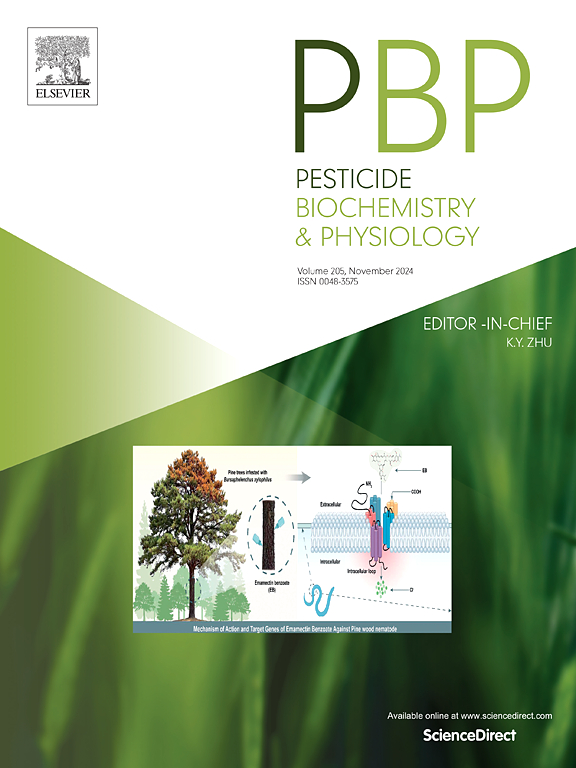亲水亲脂双嵌段聚合物纳米平台通过抑制几丁质合成提高昆虫生长调节剂的生物活性
IF 4.2
1区 农林科学
Q2 BIOCHEMISTRY & MOLECULAR BIOLOGY
引用次数: 0
摘要
昆虫生长调节剂(IGRs)在绿色有害生物治理中显示出巨大的潜力,但其防治效果低、作用滞后等问题限制了其广泛应用。近年来,各种纳米递送系统通过提高农药的生物利用度、降低用量要求、改善环境相容性等方面,使农药发生了革命性的变化。本文设计并开发了一种亲水亲脂双嵌段聚合物(HLDP),用于构建IGR双氟苯脲(DFB)的高效纳米平台。HLDP可与DFB通过静电相互作用自发组装成DFB/HLDP配合物,这种自组装形成了尺寸均匀的球形纳米粒子(136.06 nm), zeta电位大幅增加(48.27 mV)。与单独使用DFB相比,DFB/HLDP复合物对一种主要的迁徙害虫东方粘虫表现出明显更高的胃和接触毒性。RNA-seq分析显示,口服DFB/HLDP复合物上调了参与代谢、递送和几丁质合成的几个关键基因。同时,DFB/HLDP复合物可进一步降低几丁质含量和ATP水平,从而放大了DFB对几丁质生物合成的抑制作用。总之,我们的研究成功构建了基于hldp的IGRs纳米递送系统,为绿色害虫治理提供了一种创新和可持续的策略。本文章由计算机程序翻译,如有差异,请以英文原文为准。
Hydrophilic and lipophilic diblock polymer-based nanoplatform improves the bioactivity of insect growth regulator via inhibiting chitin synthesis
Insect growth regulators (IGRs) have shown great potential in green pest management, but their low control efficacy and delayed action limit their widespread application. In recent years, various nanodelivery systems have revolutionized pesticides by enhancing bioavailability, reducing dosage requirements, improving environmental compatibility, etc. Herein, a hydrophilic and lipophilic diblock polymer (HLDP) was designed and developed to construct an efficient nanoplatform for an IGR diflubenzuron (DFB). The HLDP could spontaneously assemble with DFB into DFB/HLDP complex via electrostatic interactions, and this self-assembly formed uniformly sized spherical nanoparticles (136.06 nm), with the substantial increase in zeta potential (48.27 mV). Compared to DFB alone, the DFB/HLDP complex exhibited remarkably higher stomach and contact toxicity against a major migratory pest oriental armyworm. RNA-seq analysis revealed that the oral feeding of DFB/HLDP complex upregulated several crucial genes involved in metabolism, delivery and chitin synthesis. Meanwhile, the DFB/HLDP complex could further decrease the chitin content and ATP level, which amplified the inhibitory effects of DFB on chitin biosynthesis. Overall, our study successfully constructed a HLDP-based nanodelivery system for IGRs, which offered an innovative and sustainable strategy for green pest management.
求助全文
通过发布文献求助,成功后即可免费获取论文全文。
去求助
来源期刊
CiteScore
7.00
自引率
8.50%
发文量
238
审稿时长
4.2 months
期刊介绍:
Pesticide Biochemistry and Physiology publishes original scientific articles pertaining to the mode of action of plant protection agents such as insecticides, fungicides, herbicides, and similar compounds, including nonlethal pest control agents, biosynthesis of pheromones, hormones, and plant resistance agents. Manuscripts may include a biochemical, physiological, or molecular study for an understanding of comparative toxicology or selective toxicity of both target and nontarget organisms. Particular interest will be given to studies on the molecular biology of pest control, toxicology, and pesticide resistance.
Research Areas Emphasized Include the Biochemistry and Physiology of:
• Comparative toxicity
• Mode of action
• Pathophysiology
• Plant growth regulators
• Resistance
• Other effects of pesticides on both parasites and hosts.

 求助内容:
求助内容: 应助结果提醒方式:
应助结果提醒方式:


